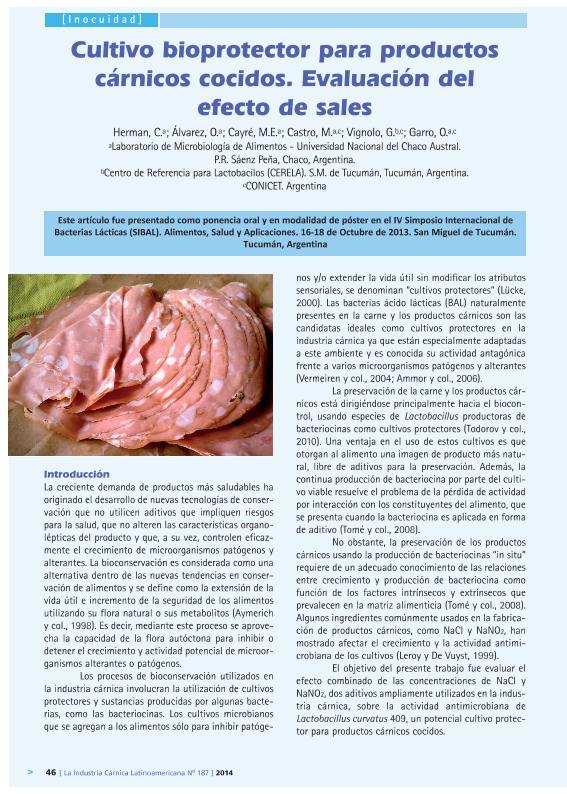Mostrar el registro sencillo del ítem
dc.contributor.author
Herman, Cristian

dc.contributor.author
Alvarez, Ornella Estefanía

dc.contributor.author
Cayre, María Elisa

dc.contributor.author
Castro, Marcela Paola

dc.contributor.author
Vignolo, Graciela Margarita

dc.contributor.author
Garro, Oscar Alfredo

dc.date.available
2017-11-24T18:35:03Z
dc.date.issued
2014-03
dc.identifier.citation
Herman, Cristian; Alvarez, Ornella Estefanía; Cayre, María Elisa; Castro, Marcela Paola; Vignolo, Graciela Margarita; et al.; Cultivo bioprotector para productos cárnicos cocidos: evaluación del efecto de sales; Publitec; La Industria Cárnica Latinoamericana; 34; 187; 3-2014; 46-49
dc.identifier.issn
0325-3414
dc.identifier.uri
http://hdl.handle.net/11336/29043
dc.description.abstract
The preservation of meat products is increasingly directed towards biocontrol using bacteriocinogenic Lactobacillus species as protective cultures to inhibit the growth of undesirable microorganisms. However, food preservation using in situ bacteriocin production requires an adequate knowledge of the relationship between cell growth and bacteriocin production as a function of the intrinsic and extrinsic factors that prevail in the food matrix. The aim of this work was to evaluate the combined effect of NaCl and NaNO2 concentrations, under refrigeration (7°C), on the antimicrobial activity of Lactobacillus curvatus 409 a strain isolated from artisanal bologna type sausage, which showed good properties as a bioprotective culture in cooked meat products. A central composite design (22 + star) was applied, being the independent variables: NaCl concentration (0.2, 1, 3, 5 and 5.8 % w/v) and NaNO2 concentration (6, 35, 105, 175 and 204 mg/L). Cell growth was tested on MRS broth supplemented with the aforementioned additives assessing optical density measurements at 600nm for 192 hours. Antimicrobial activity against Listeria innocua was carried out by means of the agar well diffusion assay and expressed as arbitrary units per ml (AU/ml). Time needed to reach the highest antimicrobial activity was used as response variable. L. curvatus 409 was able to grow and produce antimicrobial substances under all conditions tested. Analysis of results indicated that the linear effect of NaCl and NaNO2 had a significant effect on response variable. An increase in salts concentrations drove to an increase in the time necessary to reach the highest activity. Values found were in the range between 148 and 192 hours. The influence of NaNO2 resulted less pronounced when compared to NaCl. In addition, the higher the concentrations of NaCl and NaNO2, the lower the values of maximum activity. These values varied between a minimum of 50 UA/ml and a maximum of 400 UA/ml. The interaction effect between NaCl and NaNO2 was significant indicating that high NaCl concentrations together with high NaNO2 concentrations have a greater impact on time than with low NaNO2 concentrations. The results suggest that the effectiveness of L. curvatus 409 as a protective culture for cooked meat products could be affected by NaCl and NaNO2 concentrations, additives inherent to these products. Despite this fact, L. curvatus 409 could be a valuable additional hurdle in the preservation of cooked meat products. Further studies have to be carried out to evaluate this strain behavior in the control of Listeria spp in these products.
dc.format
application/pdf
dc.language.iso
spa
dc.publisher
Publitec
dc.rights
info:eu-repo/semantics/openAccess
dc.rights.uri
https://creativecommons.org/licenses/by-nc-sa/2.5/ar/
dc.subject
Cultivos Protectores
dc.subject
Salchichas Tipo Viena
dc.subject
Cloruro de Sodio
dc.subject
Nitrito de Sodio
dc.subject.classification
Alimentos y Bebidas

dc.subject.classification
Otras Ingenierías y Tecnologías

dc.subject.classification
INGENIERÍAS Y TECNOLOGÍAS

dc.title
Cultivo bioprotector para productos cárnicos cocidos: evaluación del efecto de sales
dc.type
info:eu-repo/semantics/article
dc.type
info:ar-repo/semantics/artículo
dc.type
info:eu-repo/semantics/publishedVersion
dc.date.updated
2017-10-31T17:50:45Z
dc.journal.volume
34
dc.journal.number
187
dc.journal.pagination
46-49
dc.journal.pais
Argentina

dc.journal.ciudad
Ciudad Autónoma de Buenos Aires
dc.description.fil
Fil: Herman, Cristian. Universidad Nacional del Chaco Austral; Argentina. Consejo Nacional de Investigaciones Científicas y Técnicas; Argentina
dc.description.fil
Fil: Alvarez, Ornella Estefanía. Universidad Nacional del Chaco Austral. Departamento de Ciencias Basicas y Aplicadas. Laboratorio de Microbiología de Alimentos; Argentina
dc.description.fil
Fil: Cayre, María Elisa. Universidad Nacional del Chaco Austral. Departamento de Ciencias Basicas y Aplicadas. Laboratorio de Microbiología de Alimentos; Argentina
dc.description.fil
Fil: Castro, Marcela Paola. Universidad Nacional del Chaco Austral. Departamento de Ciencias Basicas y Aplicadas. Laboratorio de Microbiología de Alimentos; Argentina. Consejo Nacional de Investigaciones Científicas y Técnicas; Argentina
dc.description.fil
Fil: Vignolo, Graciela Margarita. Consejo Nacional de Investigaciones Científicas y Técnicas. Centro Científico Tecnológico Conicet - Tucumán. Centro de Referencia para Lactobacilos; Argentina
dc.description.fil
Fil: Garro, Oscar Alfredo. Universidad Nacional del Chaco Austral. Departamento de Ciencias Basicas y Aplicadas. Laboratorio de Microbiología de Alimentos; Argentina. Consejo Nacional de Investigaciones Científicas y Técnicas. Centro Científico Tecnológico Conicet - Nordeste; Argentina
dc.journal.title
La Industria Cárnica Latinoamericana
Archivos asociados
